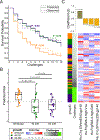Route of immunization defines multiple mechanisms of vaccine-mediated protection against SIV
- PMID: 30177821
- PMCID: PMC6482471
- DOI: 10.1038/s41591-018-0161-0
Route of immunization defines multiple mechanisms of vaccine-mediated protection against SIV
Abstract
Antibodies are the primary correlate of protection for most licensed vaccines; however, their mechanisms of protection may vary, ranging from physical blockade to clearance via the recruitment of innate immunity. Here, we uncover striking functional diversity in vaccine-induced antibodies that is driven by immunization site and is associated with reduced risk of SIV infection in nonhuman primates. While equivalent levels of protection were observed following intramuscular (IM) and aerosol (AE) immunization with an otherwise identical DNA prime-Ad5 boost regimen, reduced risk of infection was associated with IgG-driven antibody-dependent monocyte-mediated phagocytosis in the IM vaccinees, but with vaccine-elicited IgA-driven neutrophil-mediated phagocytosis in AE-immunized animals. Thus, although route-independent correlates indicate a critical role for phagocytic Fc-effector activity in protection from SIV, the site of immunization may drive this Fc activity via distinct innate effector cells and antibody isotypes. Moreover, the same correlates predicted protection from SHIV infection in a second nonhuman primate vaccine trial using a disparate IM canarypox prime-protein boost strategy, analogous to that used in the first moderately protective human HIV vaccine trial. These data identify orthogonal functional humoral mechanisms, initiated by distinct vaccination routes and immunization strategies, pointing to multiple, potentially complementary correlates of immunity that may support the rational design of a protective vaccine against HIV.
Conflict of interest statement
Competing financial interests
The authors declare no competing financial interests.
Figures





References
-
- Rerks-Ngarm S, et al. Vaccination with ALVAC and AIDSVAX to prevent HIV-1 infection in Thailand. N Engl J Med 361, 2209–2220 (2009). - PubMed
Publication types
MeSH terms
Substances
Grants and funding
LinkOut - more resources
Full Text Sources
Other Literature Sources
Medical
Miscellaneous

